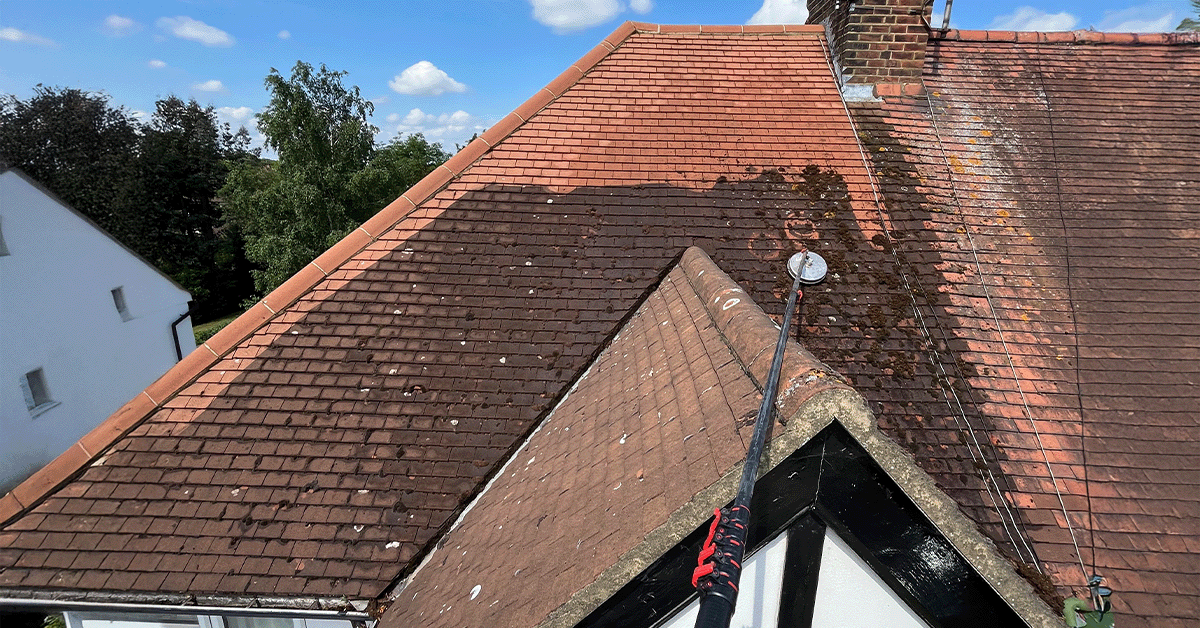If you’ve noticed ugly black streaks running down your roof, you’re not alone. These dark marks are common on homes across London and the UK. Understanding what causes black streaks on roofs is vital for protecting your home.
The main cause: algae
The main reason for black streaks is algae called gloeocapsa magma. This organism appears dark black on roof surfaces. The dark colour protects it from sun rays, letting algae grow well on rooftops across London.
This algae feeds on limestone filler in roof tiles and shingles. As it feeds, it weakens roof materials, causing protective bits to wash away when it rains. Over time, this creates serious damage to your roof structure.
The black streaks you see are piles of dead algae cells, showing a colony has been feeding on your roof.
Perfect conditions for growth
This algae loves warm, humid conditions common throughout the UK. It prefers:
- North-facing sections with limited sunlight
- Shaded areas near trees or chimneys
- Areas with poor airflow
- Places where water sits
These conditions create perfect environments for algae growth. The organisms need steady moisture to survive, explaining why black streaks appear after heavy rain.
How black streaks spread
Algae spreads through tiny spores floating in air. Wind carries spores long distances. Animals help too – birds carry spores on feet, feathers, or fur between roofs.
This explains why black streaks appear in groups within neighbourhoods. Once algae grows on one house, it threatens nearby homes through constant spore production. The problem spreads quickly, making roof cleaning services important for communities.
Hidden costs of ignoring streaks
Many homeowners think black streaks are just appearance problems, but the impact goes further:
Structural damage – Algae damages tiles and roof systems. Lost protective bits expose materials to weather damage.
Higher energy bills – Dark algae soaks up heat instead of reflecting it, increasing cooling costs.
Lower property value – Black streaks affect curb appeal. Buyers think discolouration means poor maintenance.
Early replacement – Untreated damage can mean complete roof replacement years early.
Prevention strategies
Black streaks can be prevented:
Regular maintenance
- Annual roof checks after storms
- Gutter cleaning to prevent buildup
- Tree trimming for more sunlight
Environmental management
- Remove overhanging branches
- Ensure proper attic ventilation
- Install zinc or copper strips
Professional roof cleaning For existing algae, professional roof cleaning using pet-safe methods works best. Professional roof cleaning services use soft washing techniques gentler than pressure washing. Soft wash roof cleaning combines low-pressure water with special solutions that safely break down moss and algae.
Roof materials and risk
| Material | Risk | Reason |
|---|---|---|
| Asphalt shingles | Very High | Contains limestone |
| Clay tiles | Medium | Holds moisture |
| Metal roofing | Low | Smooth surface |
| Slate | Medium | Supports growth |
Warning signs
Early detection makes treatment easier. Watch for:
- Light colour changes on north-facing sections
- Dark spots after wet weather
- Granules in gutters
- Texture changes
- Debris buildup
When to call professional

Established algae needs professional attention. Professional roof cleaning services in London use soft wash roof cleaning methods that remove moss and algae without damage.
Professional roof cleaning becomes essential when:
- Black streaks cover over 30% of surface
- Streaks persist over one season
- Surface damage appears
- DIY cleaning fails
Roof work is highly dangerous according to UK’s Health and Safety Executive. Professional roof cleaning services have training, equipment, and insurance for safe work.
Soft washing roof cleaning is safer than pressure washing, which damages materials. Professional services use low-pressure washing techniques with special solutions.
Professional treatment costs much less than early replacement, making it wise investment.
Commercial considerations
Commercial roof cleaning faces similar problems on larger scales. London business owners should consider regular commercial roof maintenance. Commercial roof cleaning services handle larger buildings safely while maintaining professional appearance.
Frequently asked questions
Q: Can I clean black streaks myself?
A: DIY cleaning can damage materials and harm plants. Professional roof cleaning uses specialised equipment and pet-safe products. Soft washing is safer than pressure washing for roof cleaning.
Q: How long before streaks return?
A: Proper cleaning keeps roofs streak-free for 2-4 years. Weather, roof direction, and plants affect duration. Regular maintenance extends this period.
Q: Does insurance cover black streaks?
A: Most policies don’t cover algae damage as it’s maintenance-related. However, structural problems might be covered. Check your policy details.
Q: Soft washing vs pressure washing?
A: Soft washing uses low pressure with cleaning solutions to safely remove moss and algae. Pressure washing uses high pressure that damages materials. Professional roof cleaning services recommend soft wash roof cleaning.
Protecting your investment
Your roof is a major investment, and black streaks threaten its function and value. Understanding algae growth and taking prevention steps protects your property. Regular roof cleaning services maintain condition and extend lifespan.
Early detection and professional treatment are key. Minor issues become major problems if untreated. Working with experienced roof cleaning services using safe soft washing methods restores appearance while protecting family and investment.
Don’t let black streaks damage your home. Take action at first signs, maintain regular inspections, and schedule cleaning. Professional roof cleaning in London offers expertise to tackle these problems safely and effectively.



